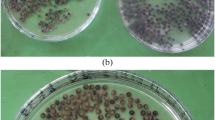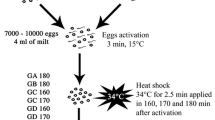Abstract
Nineteen Eastern Australian populations of the grasshopper Atractomorpha similis (Acridoidea, Pyrgomorphidae) were sampled and male meiotic chromosomes, as well as some male and female somatic mitoses, were examined. In fourteen of these populations, a proportion of the males were found to carry between one and ten extra copies of a particular autosome, the megameric chromosome (A9). Numbers of extra chromosomes varied between but not within the individual follicles of the testis. The extra chromosomes were not found in somatic tissue. In all, 20% of males from the field were germ-line polysomic and within these males, 91% of germ cells were polysomic. In meiosis, extra copies of A9 present as univalents lagged at anaphase I or II and subsequently formed micronuclei which degenerated early in spermiogenesis. As one extra univalent is the most common polysomic condition in natural populations, this elimination of univalents suggests that most polysomic males produce a large proportion of normal haploid sperm. In laboratory cultures, selection for increased frequency of germ-line polysomy, conducted over four generations, raised the proportion of polysomic males from 23% to 71%. Selection against polysomy reduced its frequency to 5%. These breeding experiments also showed that germ-line polysomy is equally transmissible through both the male and the female parent. Transmission data also suggested that these extra chromosomes can arise de novo, presumably by unequal disjunction in previously diploid lines. A computer model was devised, simulating the effects of repeated non-disjunction over a series of mitotic divisions. The behaviour of this model suggested that the distributions of extra chromosome numbers observed in the laboratory generations most probably resulted from such a series of non-disjunctions, occurring in an initially diploid cell population. It seems, therefore, that the transmission of polysomy occurs through the agency of heritable factors which determine the probability of non-disjunction and thus the accumulation of a particular autosome during a specific series of mitotic divisions in the embryonic germ-line.
Similar content being viewed by others
References
Allard, R.W.: Principles of plant breeding, chapt. 28. New York: John Wiley and Sons 1960
Barlow, P.: The influence of inactive chromosomes on human development. Humangenetik 17, 105–136 (1973)
Blakeslee, A.F.: New Jimson weeds from old chromosomes. Heredity 25, 80–108 (1934)
Bridges, C.B.: Sex in relation to chromosomes and genes. Amer. Naturalist 59, 127–137 (1925)
Comings, D.E.: In: Physiology and genetics of reproduction (F. Fuchs and E.M. Coutinho, eds.) New York: Plenum-Press 1974
Falconer, D.S.: Introduction to quantitative genetics, chapt. 10. Edinburgh: Oliver and Boyd 1960
Hayman, D.L., Martin, P.G., Waller, P.F.: Parallel mosaicism of supernumerary chromosomes and sex chromosomes in Echymipera kalabu (Marsupialia), Chromosoma (Berl.) 27, 371–380 (1969)
Hewitt, G.M.: Meiotic drive for B-chromosomes in the primary oocytes of Myrmeleotettix maculatus (Orthoptera: Acrididae). Chromosoma (Berl.) 56, 381–391 (1976)
Hewitt, G.M., John, B.: Parallel polymorphism for supernumerary segments in Chorthippus parallelus (Zetterstedt) I. British Populations. Chromosoma (Berl.) 25, 319–342 (1968)
John, B., Lewis, K.R.: Chromosome hierarchy, chapt. 3. Clarendon Press, Oxford (1975)
John, B., King, M.: Heterochromatin variation in Cryptobothrus chrysophorus I. Chromosome differentiation in natural populations. Chromosoma (Berl.) 64, 219–239 (1977a)
John, B., King, M.: Heterochromatin variation in Cryptobothrus chrysophorus II. Patterns of C-banding. Chromosoma (Berl.) 65, 59–79 (1977b)
John, B., Miklos, G.E.G.: Functional aspects of Satellite DNA and Heterochromatin. Int. Rev. Cytol. 58, 1–114 (1979)
Khush, G.S.: Cytogenetics of aneuploids, chapt. 6. New York: Academic Press 1973
King, M., John, B.: Regularities and restrictions govering C-band variation in Acridoid grasshoppers. Chromosoma (Berl.) 76, 123–150 (1980)
Lespinasse, R.: Analyse de la transmission des chromosomes surnuméraires chez Locusta migratoria migratoroides R. et. F. (Orthoptera, Acrididae). Chromosoma (Berl.) 59, 307–322 (1977)
Lewis, K.R., John, B.: Breakdown and restoration of chromosome stability following inbreeding in a locust. Chromosoma (Berl.) 10, 589–618 (1959)
Lucov, Z., Nur, U.: Accumulation of B-chromosomes by preferential segregation in females of the grasshopper Melanoplus femur-rubrum. Chromosoma (Berl.) 42, 289–306 (1973)
Lyon, M.F.: Sex chromatin and gene action in the mammalian X-chromosome. Amer. J. Hum. Genet. 14, 135–148 (1962)
Lyon, M.F.: Mechanisms and evolutionary origins of variable X-chromosome activity in mammals. Proc. roy. Soc. B. Lond. 187, 243–268 (1974)
McGrath, J., Hillman, N.: The inability of spermatozoa from sterile (t6/tw32) mice to effect in vitro fertilization. J. Cell. Biol., 75, 170a (1977)
Miklos, G.L.G., Nankivell, R.N.: Telomeric satellite DNA functions in regulating recombination. Chromosoma (Berl.) 56, 143–167 (1976)
Nagl, W.: Zellkern und Zellzyklen, p. 83. Stuttgart: Ulmer 1976
Nagl, W.: Endopolyploidy and Polyteny. In: Differentiation and evolution, chapt. 2. Amsterdam: North-Holland 1978
Nankivell, R.N.: Karyotype differences in the Crenaticeps-group of Atractomorpha (Orthoptera, Acridoidea, Pyrgomorphidae). Chromosoma (Berl.) 56, 127–142 (1976)
Nelson, O.E.: Life cycle, sex differentiation and testis development in Melanoplus differentialis (Acrididae, Orthoptera). J. Morph. 51, 467–525 (1931)
Nur, U.: Mitotic instability leading to an accumulation of B-chromosomes in grasshoppers. Chromosoma (Berl.) 27, 1–19 (1969)
Nur, U.: Asymmetrically heteropycnotic X-chromosomes in the grasshopper Melanoplus femurrubrum. Chromosoma (Berl.) 68, 165–185 (1978)
Peters, G.B.: Germ line polysomy in Atractomorpha similis. PhD thesis, Australian National University, Canberra, Australia (1977)
Rees, H., Jones, R.N.: Chromosome genetics, chapt. 4. London: Edward Arnold 1977
Rothfels, K.H., Procunier, W.S.: B-chromosomes of Neopodismopsis abdominalis (Orthoptera, Acrididae). Chromosoma (Berl.) 52, 137–148 (1975)
Sannomiya, M.: Cytogenetic studies on natural populations of grasshoppers with special reference to B-chromosomes II. Atractomorpha bedeli. Chromosoma (Berl.) 44, 99–106 (1973)
Sharma, G.P., Prashad, R., Gupta, M.L.: Chromosomal variation in the male germ cells of Chrotogonus trachypterus (Blanchard) (Orthoptera: Acridoidea: Pyrgomorphidae) from Ottu (Punjab) La Cellule 65, 295–314 (1965)
Shaw, D.D.: Genetic and environmental components of chiasma control. II. The response to selection in Schistocerca Chromosoma (Berl.) 37, 297–308 (1972)
Webb, G.C.: Chromosome organisation in the Australian plague locust Chortoicetes terminifera. I. Banding relationships of the normal and supernumerary chromosomes. Chromosoma (Berl.) 55, 229–246 (1976)
Webb, G.C., Neuhaus, P.: Chromosome organisation in the Australian plague locust Chortoicetes terminifera. II. Banding variants of the B-chromosome. Chromosoma (Berl.) 70, 205–238 (1979)
Weng, T.S.: Intra-individual variation in number of B-chromosomes in Miscanthus japonicus Anderss. Bot. Bull. Acad. Sinica, 3, 19–31 (1962)
White, M.J.D.: Asymmetry of heteropycnosis in tetraploid cells of a grasshopper. Chromosoma (Berl.) 30, 51–61 (1970)
White, M.J.D.: Animal Cytology and Evolution, 3rd edition, chapt. 9. London: Cambridge University Press 1973
Author information
Authors and Affiliations
Rights and permissions
About this article
Cite this article
Peters, G.B. Germ line polysomy in the grasshopper Atractomorpha similis . Chromosoma 81, 593–617 (1981). https://doi.org/10.1007/BF00285852
Received:
Issue Date:
DOI: https://doi.org/10.1007/BF00285852




